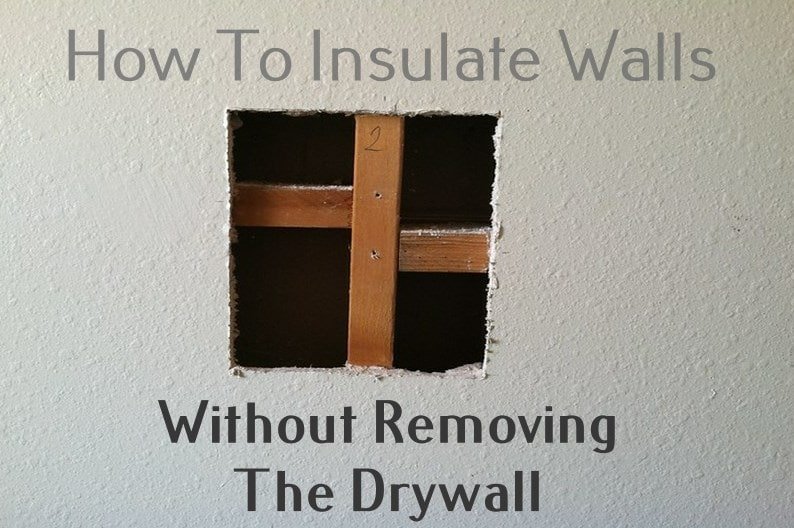Insulating Your Home Has Never Been Easier: A Guide to Non-Invasive Insulation Techniques

Image: www.krazyhog.com
Every homeowner wants to live in a cozy and energy-efficient abode, but the thought of tearing down walls for insulation can be daunting and costly. However, advancements in the insulation industry have introduced innovative methods that allow you to upgrade your home’s thermal performance without such a drastic renovation. In this article, we’ll delve into the realm of interior wall insulation without drywall removal.
Understanding the Purpose of Insulation
Insulation plays a crucial role in maintaining a comfortable indoor environment while reducing energy costs. By creating a barrier against heat transfer, insulation prevents heat loss during cold seasons and keeps the home cool during warmer months. This efficiency not only enhances comfort but also reduces the workload on your HVAC system, leading to significant savings on heating and cooling bills.
Exploring Insulation Options Without Removing Drywall
1. Injected Foam Insulation:
This method involves injecting a foam-based material into the wall cavity through small holes drilled into the drywall. As the foam expands, it fills the gaps and creates an effective thermal barrier without interrupting the drywall’s surface.
2. Spray Foam Insulation:
Similar to injected foam, spray foam insulation involves applying a liquid foam directly to the interior wall. As it expands and hardens, it seals any air leaks and gaps, providing exceptional insulation while adding structural support to the wall.
3. Cellulose Insulation:
Cellulose insulation is a highly versatile option made from recycled paper. It can be blown into wall cavities through small holes, filling all the nooks and crannies to provide excellent insulation.
4. Fiberglass Batts:
Although traditionally used in new construction, fiberglass batts can also be installed behind drywall by cutting them to fit and inserting them into the wall cavity. However, this method may require removing electrical outlets and fixtures for easier access.
Choosing the Right Insulation Option
The best insulation option for your home depends on specific factors such as climate, wall structure, and budget. Injected foam is excellent for hard-to-reach areas, spray foam provides superior air sealing, cellulose is environmentally friendly, and fiberglass batts are a cost-effective solution. Consider the advantages and drawbacks of each method before making a decision.

Image: insulationline.com
Benefits of Insulating Walls Without Drywall Removal
1. Reduced Energy Costs:
Insulating interior walls improves thermal efficiency, leading to reduced heat transfer and lower energy consumption. This means you can enjoy a warmer home in winter and a cooler one in summer without putting a strain on your energy bills.
2. Enhanced Comfort:
Proper insulation eliminates uncomfortable drafts and cold spots, creating a cozy and evenly heated living space. You’ll notice a significant improvement in your comfort levels, especially during extreme temperatures.
3. Noise Reduction:
Insulation materials can also act as acoustic barriers, reducing noise transfer between rooms. This is especially beneficial for bedrooms, home offices, and other areas where noise is a concern.
4. Improved Air Quality:
Some insulation materials, such as cellulose, have air-purifying properties that help trap dust, pollen, and other airborne particles. This can improve indoor air quality, promoting a healthier home environment.
5. Non-Invasive Installation:
The primary advantage of these insulation techniques is their non-invasive nature. You don’t need to remove, patch, or repaint the drywall, minimizing disruption and saving you time and money.
Enhancing Insulation Effectiveness
1. Seal Air Leaks:
To maximize the effectiveness of your insulation, it’s essential to seal any air leaks around electrical outlets, light fixtures, and pipes. Use caulk or foam sealant to prevent warm or cool air from escaping.
2. Consider Double-Wall Construction:
For homes in extreme climates, consider double-wall construction, where an additional layer of insulation is added to the exterior wall system. This provides an extra layer of protection against heat transfer, resulting in superior insulation.
3. Choose Energy-Efficient Windows:
Insulate around windows and replace old, drafty windows with energy-efficient models to minimize heat loss or gain through these openings.
Professional Installation for Optimal Results
While some DIY enthusiasts may attempt interior wall insulation themselves, it’s highly recommended to hire experienced professionals for optimal results. Professionals possess the necessary equipment, expertise, and safety knowledge to ensure the proper installation and effectiveness of the insulation.
How To Insulate Interior Walls Without Removing The Drywall
Conclusion
Insulating interior walls without removing the drywall is a game-changer in the world of home comfort and energy efficiency. By choosing the right insulation method and following best practices, you can reap the rewards of a warmer, quieter, and energy-conscious home without breaking the bank. Whether you’re looking to reduce energy costs, enhance comfort, or improve indoor air quality, insulating your interior walls is a smart investment that will pay off for years to come.